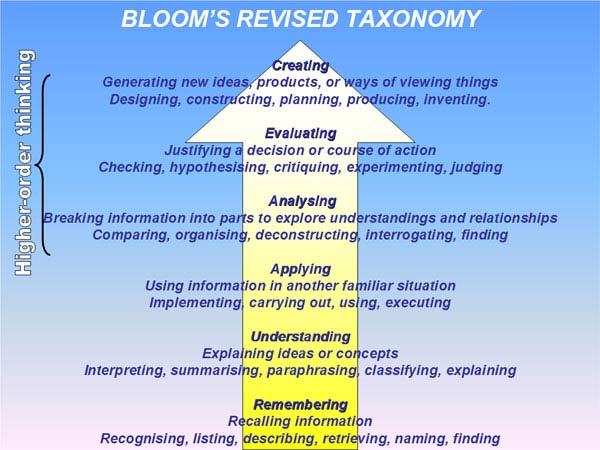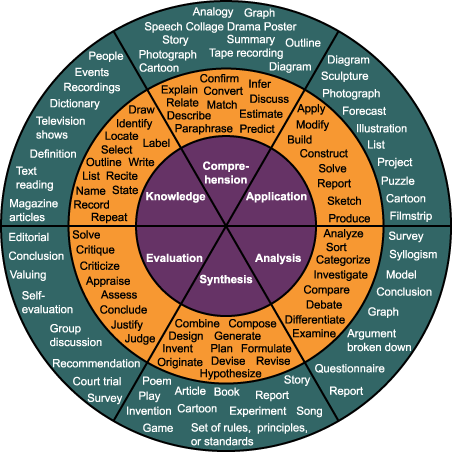|
Share
|
Bloom’s taxonomy is a classification system used to define and distinguish different levels of human cognition - i.e., thinking, learning, and understanding. It has been enshrined in current pedagogies as a tool for teaching, learning and assessment. Bloom’s taxonomy was originally published in 1956 by a team of cognitive psychologists at the University of Chicago. It is named after the committee’s chairman, Dr Benjamin Bloom (1913–1999). The original learning domains were Knowledge, Comprehension, Application, Evaluation and Synthesis. Educators have typically used Bloom’s taxonomy to inform or guide the development of assessments, curriculum and instructional methods such as questioning strategies.
In 2001 a revised version of Bloom’s taxonomy was released. The “Revised Bloom’s Taxonomy,” as it is commonly called, was intentionally designed to be more useful to educators and to reflect the common ways in which it had come to be used in schools.
In the revised version, three categories were renamed and all the categories were expressed as verbs rather than nouns. Knowledge was changed to Remembering, Comprehension became Understanding, and Synthesis was renamed Creating. In addition, Creating became the highest level in the classification system, switching places with Evaluating. In the revised version the learning domains are now Remembering, Understanding, Applying, Analysing, Evaluating and Creating.
The high order cognitive skills of Evaluating and Creating are addressed in the Australian Curriculum General Capabilities of Critical and Creative Thinking. These are viewed as pivotal 21st Century skills.
See also Critical Thinking
In 2001 a revised version of Bloom’s taxonomy was released. The “Revised Bloom’s Taxonomy,” as it is commonly called, was intentionally designed to be more useful to educators and to reflect the common ways in which it had come to be used in schools.
In the revised version, three categories were renamed and all the categories were expressed as verbs rather than nouns. Knowledge was changed to Remembering, Comprehension became Understanding, and Synthesis was renamed Creating. In addition, Creating became the highest level in the classification system, switching places with Evaluating. In the revised version the learning domains are now Remembering, Understanding, Applying, Analysing, Evaluating and Creating.
The high order cognitive skills of Evaluating and Creating are addressed in the Australian Curriculum General Capabilities of Critical and Creative Thinking. These are viewed as pivotal 21st Century skills.
See also Critical Thinking
 (Tarlinton 2003)
(Tarlinton 2003)Using Bloom's to plan for learning and assessment
(Tientanopajai 2014).
(Tientanopajai 2014).
Your browser does not support viewing this document. Click here to download the document.
| blooms_taxonomy_teacher_planning_kit1.pdf | |
| File Size: | 110 kb |
| File Type: | |
Note: this planning kit is based upon the original taxonomy but can still be easily adapted and applied to the Revised Taxonomy
Bloom’s Digital Taxonomy Verbs
Bloom's Verb and Task Wheel
 (Belshaw 2009, Flickr)
(Belshaw 2009, Flickr)Bloom's Taxonomy and a pen
Remembering – This would be something simple as “What is a pen? What does it look like?”. Very simple information that just needs someone to have recall memory. This is the lowest level of questioning you can have, but it is often the one we use too much in our classrooms.
Understanding - Although a step up from the knowledge level, a question for this could be, “What are some uses for a pen? It can be used to write but are there other things as well?”
Applying – Now that you know what a pen is used for, how do you use it? With your source of knowledge about the pen, how could you apply this to whatever you need a pen to do?
Analysing – A pen is more than just one part. If you are able to take apart that pen, what is the function of each part? What is each part’s importance and role in making that pen being able to do the task it is used for?
Evaluating - Now looking at the pen and building upon all of the knowledge you have, is the pen the best way to be doing the things that it is currently used for? You have decided that a pen is not the best way to write, but what are the arguments and reasons that you have for coming to this conclusion? You are now sharing a viewpoint with critical points to back up your ideas.
Creating -This is where you take other knowledge and apply it to the knowledge that you have of the pen. For example, you may want to create a pen or some other device for writing or drawing. Alternatively, you may want to compose a piece of creative writing or create an artwork using a pen.
More Bloom's resources
Bloom's Taxonomy Wheel for iPad Apps
Bloom's Digital Taxonomy and SAMR (Substitution, Augmentation, Modification, Redefinition)
PadWheel Poster
Remembering – This would be something simple as “What is a pen? What does it look like?”. Very simple information that just needs someone to have recall memory. This is the lowest level of questioning you can have, but it is often the one we use too much in our classrooms.
Understanding - Although a step up from the knowledge level, a question for this could be, “What are some uses for a pen? It can be used to write but are there other things as well?”
Applying – Now that you know what a pen is used for, how do you use it? With your source of knowledge about the pen, how could you apply this to whatever you need a pen to do?
Analysing – A pen is more than just one part. If you are able to take apart that pen, what is the function of each part? What is each part’s importance and role in making that pen being able to do the task it is used for?
Evaluating - Now looking at the pen and building upon all of the knowledge you have, is the pen the best way to be doing the things that it is currently used for? You have decided that a pen is not the best way to write, but what are the arguments and reasons that you have for coming to this conclusion? You are now sharing a viewpoint with critical points to back up your ideas.
Creating -This is where you take other knowledge and apply it to the knowledge that you have of the pen. For example, you may want to create a pen or some other device for writing or drawing. Alternatively, you may want to compose a piece of creative writing or create an artwork using a pen.
More Bloom's resources
Bloom's Taxonomy Wheel for iPad Apps
Bloom's Digital Taxonomy and SAMR (Substitution, Augmentation, Modification, Redefinition)
PadWheel Poster
Share on Facebook and Twitter
References and Further Reading
Adding rigor and technology into your lesson plans. (2015). Bloom's Taxonomy: Teacher Planning Kit. Adding Rigor and Technology Into your lesson Plans. Retrieved from http://techinfusedlessons.weebly.com/blooms-taxonomy-teacher-planning-kit.html
Anderson, L. W., Krathwohl, D. R., & Bloom, B. S. (2001). A taxonomy for learning, teaching, and assessing: A revision of Bloom's taxonomy of educational objectives. Allyn & Bacon.
Carrington, A. (2012). The Padagogy Wheel … it's a Bloomin' Better Way to Teach. In Support of Excellence. Retrieved from http://designingoutcomes.com/the-padagogy-wheel-its-a-bloomin-better-way-to-teach/
Couros, G. (2010). Bloom's Taxonomy and a Pen. The Principal of Change. Retrieved from: http://georgecouros.ca/blog/archives/430
Educational Origami. (2016). Bloom's Digital Taxonomy. Edorigami.wikispaces.com. Retrieved from http://edorigami.wikispaces.com/Bloom%27s+Digital+Taxonomy
Educational Technology and Mobile Learning. (2013). A New Fantastic Bloom's Taxonomy Wheel for iPad Apps. Educational Technology and Mobile Learning. Retrieved from http://www.educatorstechnology.com/2014/03/a-new-fantastic-blooms-taxonomy-wheel.html
Educational Technology and Mobile Learning,. (2013). A New Wonderful Wheel on SAMR and Bloom's Digital Taxonomy. Educational Technology and Mobile Learning. Retrieved from http://www.educatorstechnology.com/2013/05/a-new-wonderful-wheel-on-samr-and.html
Educational Technology and Mobile Learning. (2014). New: Bloom's Taxonomy Planning Kit for Teachers. Educatorstechnology.com. Retrieved from http://www.educatorstechnology.com/2014/03/new-blooms-taxonomy-planning-kit-for.html
Ferlazzo, L. (2009). The Best Resources For Helping Teachers Use Bloom's Taxonomy In The Classroom. Retrieved from: http://larryferlazzo.edublogs.org/2009/05/25/the-best-resources-for-helping-teachers-use-blooms-taxonomy-in-the-classroom/
Gate Four,. (2013). Bloom's Revised Taxonomy. GATE: grade 4. Retrieved from: http://grade4gate.weebly.com/blooms-revised-taxonomy.html
Global Digital Citizens. (2015). Bloom's Digital Taxonomy Verbs [Infographic]. Global Digital Citizen Foundation. Retrieved, from https://globaldigitalcitizen.org/blooms-digital-taxonomy-verbs
Great Schools Partnerships. (2013). Bloom’s Taxonomy Definition. The Glossary of Education Reform. Retrieved from http://edglossary.org/blooms-taxonomy/
Kumar, A. (2014). Bloom's Taxonomy. MaxVibrant. Retrieved from: http://www.maxvibrant.com/bloom-s-taxonomy/bloom-s-taxonomy
MacMeekin, M. (2014). Blooms revised taxonomy with verbs. An ethical island. Retrieved from https://anethicalisland.wordpress.com/2014/06/05/blooms-revised-taxonomy-with-verbs/
Puentedura, R. (2014). SAMR and Bloom's Taxonomy: Assembling the Puzzle. Common Sense Education. Available at: https://www.commonsense.org/education/blog/samr-and-blooms-taxonomy-assembling-the-puzzle.
(See also What is the SAMR model? on YouTube: https://www.youtube.com/watch?list=PL8TjVyuBdsCmZeSjU-l4qCpX11XENxsRi&v=9b5yvgKQdqE )
Tarlinton, D. (2003). Creating, evaluating, analysing, applying, understanding, remembering - Bloom’s Revised Taxonomy: Creating, generating new ideas. Retrieved from http://slideplayer.com/slide/6356429/
Tientanopajai, K (2014). Learning Tools and Media for 21st Century Students. Institute of Learning and Teaching Innovation. Khon Kaen Univesity. Retrieved from https://www.slideshare.net/kinetickitty/learning-tools-and-media-for-21st-century-students

Our Virtual Library by Cathy Costello is licensed under a Creative Commons Attribution-NonCommercial-ShareAlike 4.0 International License.
Cathy Costello teacher librarian virtual library Cathy Costello teacher librarian virtual library Cathy Costello library Cathy Costello virtual library Cathy Costello librarian


